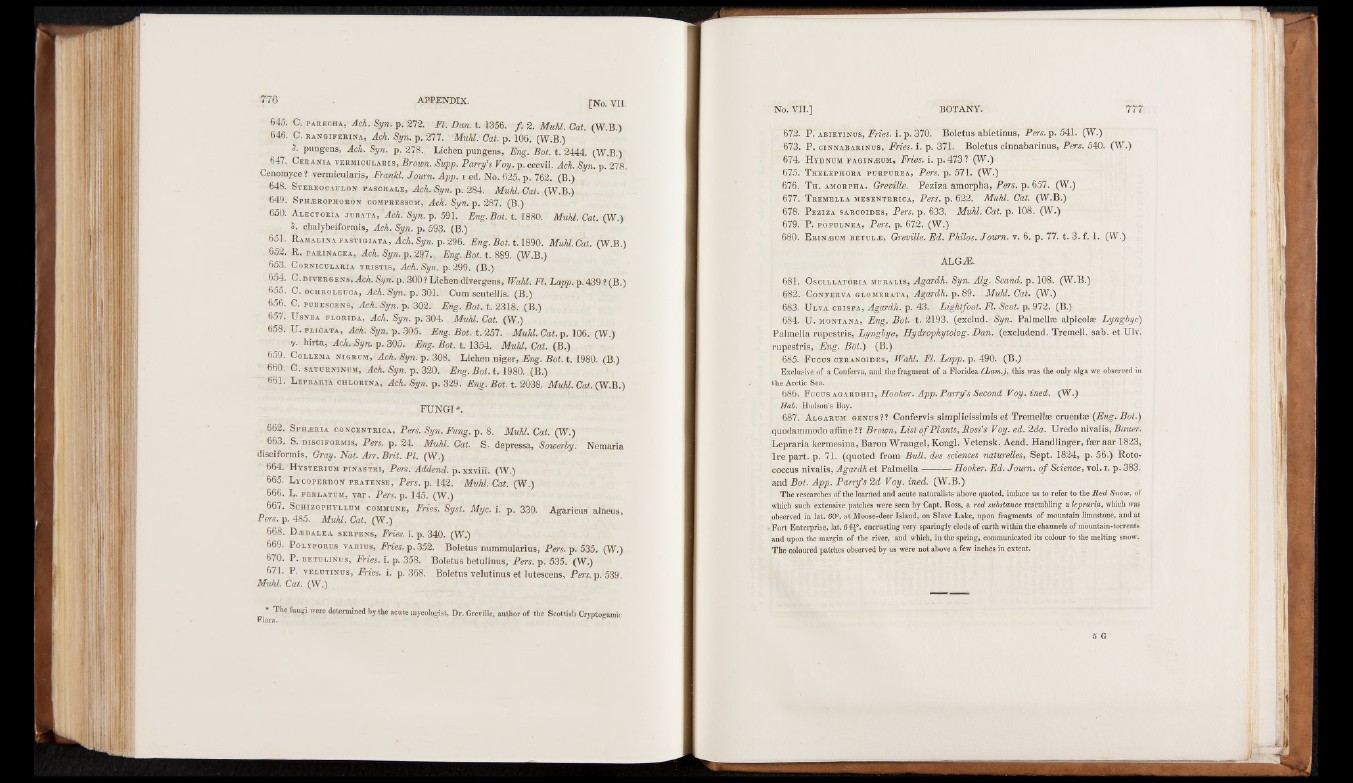
645. C. parechA) Ach. Syn. p. 272. FI. Dan. t. 1356. ƒ. 2. Muhl. Cat. (W.B.)
646. C. rangiferina, Àch. Syn. p. 277. Muhl. Cat. p. 106. (W.B.)
î. pungens, Ach. Syn. p. 278.. Lichen pungens, Eng. Bot. t. 2444. (W.B.)
647. Ce rania TERMicDiARig, Brown. Supp. Parry's Voy. p. cccvii. Ach. Syn. p. 278.
Cenomyce ? vermicularis, Frankl. Journ. App. i ed. No. 625, p. 762. (B.)
648. Stereocaulon paschale, Ach. Syn. p . 284. Muhl. Gat. (W.B.)
649. Sphærophoron compressum, Ach'. Syn. p. 287. (B.)
650. A lectoria jubata, Ach. Syn. p. 591. Eng. Bot. t. 1880. Muhl. Cat. (W .)
$. chalybeiformis, Ach. Syn. p. 593. (B.)
651. RAMAii'NAEASTiGiATA, AciSÿjî. p. 296. Eng. Bot. 1.1890. Muhl. Cat. (W.B.)
652. R. farinaqea, Ach. Syn.$, 297.. Eng. Bot. t. 889. (W.B.)
653. C ornicdlaria t r is t is , Ach. Syn. p. 299. (B.)
654. C. nrvFRQEN^, Ach. Syn'p. 300? Lichendivergens, Wahl. FI, Lapp. p.439.? (B.)
655. C. ochroleuca, Ach. Syn. p. 301.' Cum scutellis. (B.)
656. C. pubescens, Ach. Syn. p. 302. Eng. Bot. L 2318. (B.)
657. Usnea FLORIDA, Ach. Syn. p. 304. Muhl. Cat. (W.)
658. U. pucata, Ach. Syn. p. 305. Eng. Bot. t,257. Muhl. Cat. p. 106. (W.)
v. hirta, AcEByn. p. 305. Eng. Bot. t. 1354. Muhl. Cat. (B.)
659. C ollema nigrum, Ach. Syn. p. 308. Lichen niger, Eng. Bot. t. 1980. (B.)
660. C. saturninum, Ach. Syn. p. 320. Eng. Bot. 1 .1980. (B.)
’ 661- Repharia chlorina, Ach. Syn. p. 329. Eng. Bot. t. 2038. Muhl. Cat. (W.B.)
FUNGI*.
662. Sphæ ria concentrica, Pers. Syn. Fung. p . 8. Muhl. Cat. (W .)
663. S. nisciFORMis, Pers. p. 24. Muhl. Cat. S. depressa, Sowerby. Nemaria
disciformis, Gray. Nat. Arr. Brit. PI. (W.)
664. H tsterium pin a st r i, Pers. Addend, p. xxviii. (W .)
665. Lycoperdon pratense, Pers. p. 142. Muhl.-Cat. (W.)
666. L. perlatum, yar. Pers. p. 145. (W.)
667. S chizophyllum commune, Fries. Syst. Myc. i. p . 330. Agaricus alheus,
Pers. p. 485. Muhl. Cat. (W.)
668. D ædalea serpens, Fries, i. p. 340. (W .)
669. Polyporus yarius, Fries, p. 352. Boletus nummularius, Pers. p. 535. (W.)
670. P. betulinus, Fries, i. p. 358. Boletus betulinus, Pers. p. 535. (W.)
671. P. v elutinus, Fries', i. p.368. Boletus yelutinus et lutescens, P‘rrs. p. 539.
Muhl. Cat. (W.)
* The fungi were determined by the acute mycologist, Dr. Greville, author of the F lora. Scottish Cry1p tog°amie
672. P. abietinus, Fries, i. p. 370. Boletus abietinus, Pers. p. 541. (W.)
673. P, cinnabarinus,. Fries. i. p. 371. Boletus cinnabarinus, Pers. 540. (W.)
674. H ydnum fa g in .®um, Fries, i. p.473? (W.)
675. T helephora purpur ea, Pers. p. 571. (W.)
676. Th . amorpha. Greville. Peziza amorpha, Pers. p.657. (W.)
677. T remella mesenterica, Pers. p. 622. Muhl. Cat. (W.B.)
678. P eziza sarcoides, Pers. p. 633.. Muhl. Cat. p. 108. (W.)
679. P. po pu ln ea , Pers. p. 672. (W.)
680. E r in 2eum betul^e , Greville. Ed. Philos. Journ. v. 6. p. 77. t. 3. f. 1. (W.)
ALGA2.
681. O soillatoria mural i s , Agardh. Syn. Alg. Scand. p. 108. (W.B.)
682. C onferva glomerata, Agardh. p. 89. Muhl. Cat. (W.)
683. U lva cr ispa, Agardh. p. 43. Lightfoot. FI. Scot. p. 972. (B.)
684. U. Montana, Eng. Bot. t. 2193. (exclud. Syn. Palmellee alpicolae Lyngbye)
Palmella rupestris, Lyngbye, Hydrophytolog. Dan. (excludend. Tremell. sab. et Ulv.
rupestris, Eng. Bot.) (B.)
685. Fucus ceranoides, Wahl. FI. La/pp. p. 490. (B.)
Exclusive of a Conferva, and the fragment of a Floridea (Lam.), this was the only alga we observed in
the Arctic Sea.
686. Fucus AGARDHii, Hooker. App. Parry's Second Voy. ined. (W.)
Hab. Hudson’s Bay.
687. Algarum genus?? Confervis simplicissimis et Tremelke cruentae {Eng. Bot.)
quodarnmodo affine?? Brown, List o f Plants, Ross’s Voy. ed. 2da. Uredo nivalis, Bauer.
Lepraria kermesina, Baron Wrangel, Kongl. Vetensk. Acad. Handlinger, faeraar 1823,
Ire part. p. 71. (quoted from Bull, des sciences naturelles, Sept. 1824, p. 56.) Rotococcus
nivalis, Agardh et Palmella---------Hooker. Ed. Journ. of Science, vol. i. p. 383.
and Bot. App. Parry's 2d Voy. ined. (W.B.)
The researches of the learned and acute naturalists above quoted, induce us to refer to the Red Snow, of
which such extensive patches were seen by Capt. Ross, a red substance resembling a lepraria, which was
observed in lat. 60°. at Moose-deer Island, on Slave Lake, upon fragments of mountain limestone, and a^
Fort Enterprise, lat. 64£°. encrusting very sparingly clods of earth within the channels of mountain-torrents
and upon the margin of the river, and which, in the spring, communicated its colour to the melting snow.
The coloured patches observed by us were not above a few inches in extent.